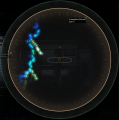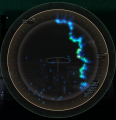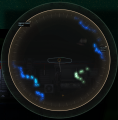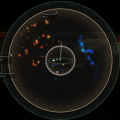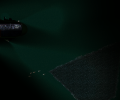User:DoryL
Hi there! I'm mostly a campaign person when it comes to playing Barotrauma, although I do occasionally play public games too. On this page you'll find pages I'm sandboxing in preparation of major edits and/or total rewrites. When I make pages, I attempt to include as much detail as possible to allow even the most technically-inclined players to gain something new by reading. I draw a lot from the game files, but I try to keep major spoilers confined to collapsible sections as to avoid ruining the experience of new players.

|
Data is potentially outdated |
| Last updated for version 0.18.15.0 The current game version is 1.3.0.4 Notes: Biome level generation parameters is out of date |
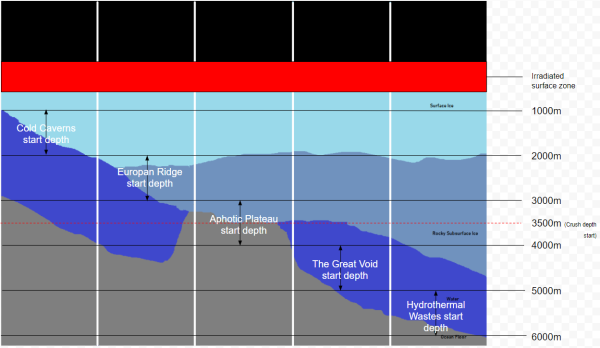
Biomes are the different regions of Europa's oceans which each exhibit unique geological and ecological properties, along with different levels of human and alien presence. In gameplay terms, this means that levels in different biomes will exhibit different overall shapes, as well as having differing probabilities of spawning various features, such as minerals, caves, wrecks, and alien ruins.[1] In total, there are currently six biomes present in the game; five are available for exploration regardless of game mode while the sixth is a campaign-exclusive biome with major story significance.[2] There is an arguably an additional seventh pseudo-biome in the form of the Abyss, which is generated below the main biome of the level. However, outside of the campaign, it is impossible to select exactly which biome a mission will take place in, with that being randomly chosen when the level is created.
Canonically, Europa's surface consists of several kilometer thick ice sheets which are constantly bombarded by jovian and solar radiation, rendering it completely devoid of either alien or human habitation. These ice sheets serve as a shield for the ocean below, allowing for the presence of complex life within these waters, which only become more common and more dangerous as one travels deeper and the water becomes warmer. In these warmer waters, chemosynthetic bacteria thrive on the geothermal activity that keeps it so, providing more nutrients for the growth of larger monsters. Due to this, the majority of human settlement is concentrated in the colder and shallower portions of Europa's oceans, which are home to much fewer predators that could endanger the colonists.[3] However, the same can not be said of the alien precursors, for their ruins and artifacts actually become more common in the deeper regions of Europa, not less. Alien presence is almost completely absent in the shallowest parts, suggesting that they never attempted to settle these regions.[4]
Common Features
Despite the vast differences between each biome, there are some elements that will always be present regardless of location. Caves, albeit of different types, will be present no matter where in Europa's oceans the player travels, however they may become more or less frequent depending the biome. Plants and minerals too appear in every passageway, although it should be noted that like caves, the exact minerals which can be found will vary from biome to biome.[5] Plants, on the other hand, will appear with the same frequency regardless of where the player is.[6]
Another commonality between every biome is the presence of, and access to, the Abyss. The Abyss spawns beneath the main route of every level, and can be accessed through either holes in the passage floor or through a gap next to the outpost at the end of the level. The former method is not always possible depending on the biome and the random generation, but the latter method will always work,[7] as to guarantee a way to access the Abyss.
Cold Caverns

The shallowest biome, and the first one encountered in the campaign, is the Cold Caverns. The rock and ice combination that comprises the walls is a soft, dark shade of blue due to the near absence of flora that would coat the walls. For a similar reason, the water is a very dark blue-green shade, as there is little in the way of any activity that would color it.[1] However, this isn't to say that region is entirely devoid of life; the walls are host to occasional colonies of two lichen-like species referred to internally as Ice Hair and Ice Buckthorn,[8] along with several other more useful species of plant found in every biome of Europa.
In terms of passage layout, the Cold Caverns are fairly forgiving in terms of danger and ease of navigation. There are few, if any, side passages present in the Cold Caverns, meaning crews will rarely have to check narrow tunnels that the submarine can not fit through in order to find resources or other points of interest. There is also a notable lack of holes to the Abyss; the bottom is almost always completely closed, meaning there is usually a surface to catch the submarine before it sinks beneath crush depth from flooding. Even when there is a hole leading to the Abyss, there will only ever be one in a given passageway, so if a crew is able to get past it, they will not need to worry anymore about being crushed. Besides the Abyss, the only other non-living threat is the presence of ice spires and icebergs, which, upon impact, will cause moderate breaches to the hull of the submarine.
In accordance with the low amount of danger the Cold Caverns poses, the potential rewards a crew can find are of limited value. Alien ruins are completely absent, removing one of the main avenues of obtaining alien materials and genetic material. Submarine wrecks are also quite rare, and Thalamus wrecks are completely unheard of in the Cold Caverns. Fortunately for those who do happen to stumble upon wrecks, the items inside are still of decent quality and usefulness, although not to the same degree as wrecks found further in the depths.[9] Caves, on the other hand, remain quite common, with two to three generating per level. However, similar to other points of interest in this biome, the rarity and value of the minerals found within are reduced compared to elsewhere on Europa.[10]
The Cold Caverns, being so distant from the geothermal activity that sustains life on Europa, are canonically home to fewer species of fauna than other biomes, although this isn't reflected in game modes other than campaign.[11]
-
A large colony of what appear to be Feathered Tubeworms, as well as two smaller colonies.
-
A closeup of two large colonies of feathered Tubeworms
-
Three Ice Spires, as they appear on Sonar.
-
Two Ice Spires, as they appear outside the submarine
Everything below this line is what was previously there and I haven't touched yet.
Europan Ridge
The second Biome encountered within a Campaign is the Europan Ridge. This region is composed of a rocky pack-ice, dotted with various unknown flora. Civilization is still fairly common, but empty geographical features are more likely than within the Cold Caverns. There are several environmental hazards found in this biome. Great currents, powerful enough to move a submarine, are present within the majority of every passage. These currents can be detected on Sonar, and are capable of pushing submarines into obstacles or even into The Abyss. The strength of Currents will periodically wane, allowing subs to push through them. Slime Molds can also be found hanging from the ceilings of some passages. These Slime Molds apply drag to the Submarine, slowing it down considerably.
Ballast Flora Spores are encountered in this region and can be detected on Sonar when a submarine is close enough, or spotted by gunners well in advance of contact. Ballast Flora can also be found suspended within currents, where it is much harder to detect with Sonar.
Large floating Icebergs also spawn within this biome, and much like Ice Spires, are highly visible on Sonar. Unlike Ice Spires, Icebergs are extremely durable and require several railgun rounds to break apart, and they will move up and down as currents change direction.
Additionally, Submarines will encounter Sonar Flora, a purple-pink and pulsating growth that heavily disrupts Sonar. The signature appears as a large red-orange cluster of pips, similar in shape and color to a Black Moloch, or volcano.
-
A moderately strong current, as it appears on sonar
-
A large floating Iceberg, as it appears on Sonar
-
Sonar flora, as it appears on Sonar
-
A large Floating Iceberg as it appears externally.
-
Slime Mold, as it appears outside the Submarine
Packs of Crawlers commonly spawn in groups of 5-7 and Spinelings spawn in groups of 2-5, with pairs or trios of Armored Mudraptors also spawning regularly. Individual Moloch and Hammerheads will begin to spawn naturally, and Bone Threshers and Tiger Threshers spawn in greater numbers. Within passageways over 25%, Moloch are encountered with increased frequency, and hammerhead attacks become more common.
The Aphotic Plateau
3rd major biome in a campaign. A great variety of monsters spawn, monster spawns increased. Civilization is sporadic.
The Great Sea
4th Major biome in a campaign. Civilization is not present, and players will have to activate Beacon Stations and clear Hunting Grounds to help new settlements appear. The levels have little to no floor, so care is advised because a sinking submarine may fall directly into the Abyss below, often below its Crush Depth, where it can fall prey to Abyss creatures. Floating rocks with Piezo Crystals, Ice Spires protruding from the cavern walls and vertically drifting ice boulders spawn. Molochs (solitary, rarely Black Molochs), Watchers (solitary) and Hammerheads (groups of 1-2, rarely Golden Hammerhead) are common. Players will also be attacked by swarms of Crawlers (3-6), Mud Raptors (2-4), rarely Spinelings (~3-4), and most often single Bone Threshers (spawning alongside 2-4 Tiger Threshers). Ballast Flora is also present, but less common than in the previous biomes. Wrecks are generated randomly throughout the level and they may be host to a Thalamus.
Hydrothermal Wastes
Final major biome in a campaign.
Eye of Europa
Biome Level Generation Parameters
| Identifier | Difficulty Range |
Formations | Structures | ||||||
|---|---|---|---|---|---|---|---|---|---|
| Ice Spire Amount |
Iceberg Amount |
Cave Amount |
Side Tunnel Amount |
Abyss Hole Probability |
Alien Ruin Amount |
Wrecks | |||
| Amount | Thalamus Probability | ||||||||
| coldcavernsbasic | 1% - 22% | 5 | 0 | 2 | 0 - 1 | 0% | 0 | 0 - 1 | 0% |
| coldcavernsmaze | 1% - 22% | 10 | 0 | 3 | 3 | 0% | 0 | 0 - 1 | 0% |
| ridgebasic | 12% - 38% | 0 | 3 | 3 | 2 | 60% | 0 | 0 - 1 | 20% |
| plateaubasic | 28% - 55% | 0 | 0 | 3 | 1 | 90% | 1 | 0 - 1 | 30% |
| greatseabasic | 45% - 72% | 5 | 20 | 1 | 1 | 90% | 1 | 1 | 40% |
| wastesbasic | 62% - 88% | 0 | 0 | 2 | 1 - 3 | 80% | 1 | 1 | 50% |
| endlocationbasic | 78% - 100% | 0 | 20 | 0 | 0 - 1 | 0% | 0 | 0 | |
References
- ↑ 1.0 1.1 1.2 https://barotraumagame.com/gameplay-features/sneak-peek-the-environment-overhaul
- ↑ The file containing the definitions for the biomes, ...\Barotrauma\Content\Map\Biomes\Biomes.xml, lists the end location as its own biome.
- ↑ Taken from the loading screen tips, found in ...Barotrauma\Content\Texts\English\EnglishVanilla.xml on lines 12 through 75.
- ↑ This is not confirmed in-game, but the level parameters for the Cold Caverns mean that ruins will never spawn there.
- ↑ Mineral spawn chances are found in ...Barotrauma\Content\Items\Materials\minerals.xml.
- ↑ Medical plant spawn chances are found in ...Barotrauma\Content\Items\Materials\medmaterials.xml.
- ↑ Verified by checking the level generation parameter files for every biome.
- ↑ Names taken from the Cold Caverns object sprites, found in ...Barotrauma\Content\Map\Biomes\ColdCaverns\ColdCavernsObjects.xml.
- ↑ Based on empirical testing, chances of rare item spawns has not been confirmed through the game files.
- ↑ Level generation parameters for the Cold Caverns are found in ...Barotrauma\Content\Map\Biomes\ColdCaverns\ColdCaverns.xml.
- ↑ Non-campaign spawn lists are found in ...Barotrauma\Content\randomevents_lineardifficulty.xml


